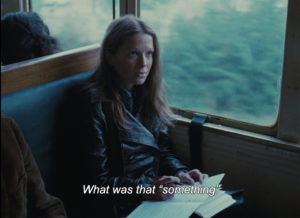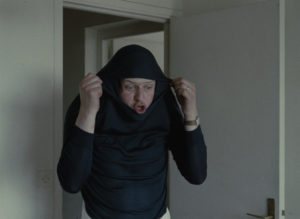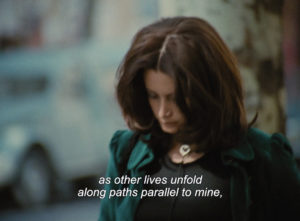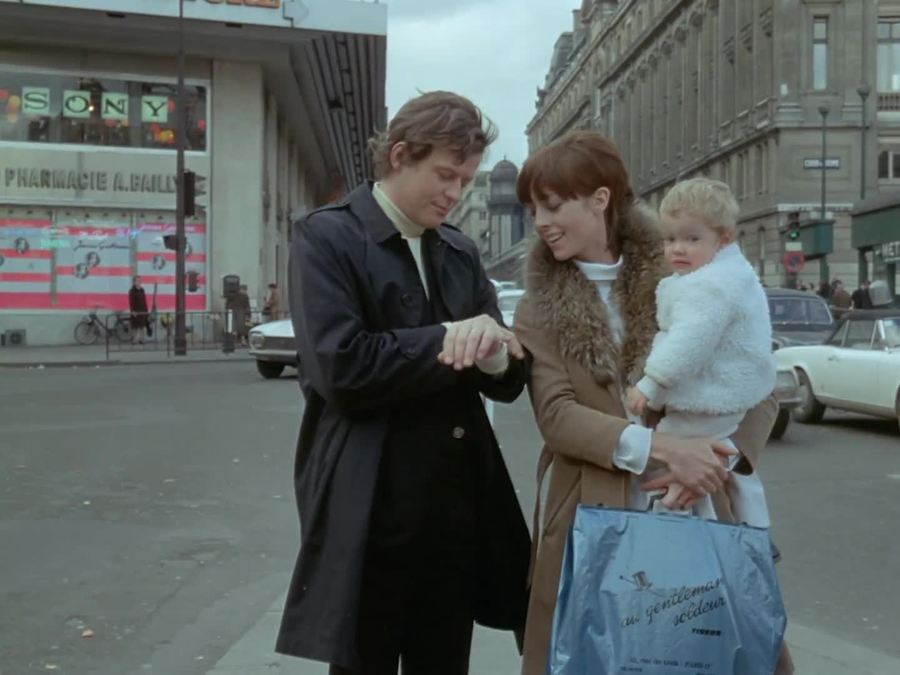I have never been one to condone cheating, as I mention in my essay about Agnes Varda’s film Happiness (1965), but in Eric Rohmer’s 1972 film, L’Amour l’après-midi or Love in the Afternoon, he approaches the subject of cheating more subtly, and the ending is much happier than Varda’s. One of the film’s characters is named Chloé, which was actually my name before Mina, so watching the film felt very strange, hearing “Chloé” constantly. Nonetheless, I’m glad I wasn’t the Chloé in this movie.
This film was part of Rohmer’s Six Moral Tales, a film series he started in 1963 with the twenty-six-minute short The Bakery Girl of Monceau and effectively ended with Love in the Afternoon in 1972. Rohmer based his series on the 1927 German film, Sunrise, directed by F. W. Morneau, which follows a foundational structure that entails a man who is committed to a woman through a relationship or marriage but then becomes enticed by another woman, however, ultimately goes back to the first woman. Rohmer follows this structure throughout his series, but for example, his first short follows a man who sees a woman in the street whom he instantly falls in love with, but he can’t find her again. He then starts to flirt with a girl who works in a bakery, until he finds the first woman again. All six films focus on the male protagonist’s thoughts and each of them discovers new thoughts or ideas that might have been buried within their subconsciousness. Love in the Afternoon was no different by having the male protagonist narrate most of the film through his internal thoughts and realizing that cheating definitely wouldn’t be the answer to what he was looking for, even though he wasn’t sure what the correct answer would be.
Love in the Afternoon begins with Frédéric and Hélène Carrelet, played by Bernard and Françoise Verley—who were real-life husband and wife—, the two leading a very content life with one child and another on the way. Frédéric works at an office while Hélène works at home, but during the time he is away from her, whether it be on the way to work or during lunch, he has meddlesome thoughts about other women. He wonders what his life would be like if he were to marry someone else or why it was Hélène that he fell in love with three years ago. He is not unhappy with his marriage, nor does he think about these thoughts negatively; he is merely looking at his love life from different perspectives.

Frédéric (Bernard Verley) internally voicing his thoughts about his relationship while looking at a woman on a train.
These thoughts stay as thoughts and don’t affect his waking life until Chloé, an old acquaintance played by Zouzou, comes into his office unexpectedly. Even though Frédéric does not care for her, he is polite and tries to amuse her. She tells him about her travels, relationships, and recent troubles. Eventually, she comes around more often, and Frédéric ends up falling in love with her, but they only meet in the afternoon – hence the name Love in The Afternoon. Frédéric’s desire for her burned deep, but he realized that he was being used like a toy, just as he had feared. One day, when he goes over to her apartment with the plan to make love, he pulls his sweater over his head and looks in the mirror. The simple act of seeing his goofy appearance in the mirror, much like what he would do to make his children laugh, was enough to shake himself into realizing that he loved Hélène too much. Thus, Frédéric sneaks out and goes home to make love to his wife instead.

Frédéric making a funny face at his baby.

Frédéric realizing the direness of the situation he is in due to seeing the same face he made to make his children laugh while in another woman’s home.
While the story has a happy ending, Rohmer raises the question of, “what happens when we become bored with our relationships?” Indeed, even I have wondered what my life would be like if I had not married, or had simply met someone different, although I would never act upon those thoughts. On the other hand, Frédéric’s views derive from a place deeper than boredom because he mentions that as a child, he used to dream about a device around his neck that would take the free will of any woman he passes. When he discusses his dream, the film immediately cuts to him controlling the women he passes by with a glowing pendant on his neck. There is no indication that it is a dream, but we know it is fake since the women are those who he saw walking past the café he was daydreaming in. I feel as though this is a stage in a real relationship and happens with almost everybody, that curiosity of “what if”. Most times, it slowly creeps up on us, or one day you realize that you feel differently, which is why Rohmer made it very evident that Frédéric was struggling with the thoughts about why he was thinking about other women. For Frédéric, to realize how in love he was with his wife, he ended up cheating, to an extent. But, I hope you will find less harmful solutions that provide the same revelation, for those of you who have had similar thoughts.
The film also briefly discusses how every person is their own main character and has a life just as complex as our own. Frédéric questions this idea by looking at the women who he sees in the streets of Paris, wondering where they are going, what they are like, and what they do for pleasure. With an informal and not-yet-certified word in the dictionary, I have found that the common term to describe this feeling is “sonder”. I was in awe at how eloquently Rohmer was able to phrase the feeling through Frédéric’s character, as there is no easy way to describe it unless you’ve experienced the feeling for yourself.

Frédéric’s internal monologue talking about the word “sonder.”
Love in the Afternoon and several other French New Wave films we have covered, such as Happiness (1965), Jules and Jim (1962), Breathless (1960), and Hiroshima My Love (1960), all center around how love can take on different forms and the various forms of heartbreak. Thus, French New Wave films have widened my understanding of what it means to love someone wholeheartedly, including myself. I firmly believe that with the plethora of dating apps and instant messaging that takes away face-to-face communication —despite the conditions with COVID-19 this year— the love stories my generation has come to know are less impactful and meaningful than those portrayed in New Wave films. Each film was full of originality, creativity, and in most instances, told an unapologetically bold story. Maybe that’s what love needs during today’s day and age— a little bit more inspiration, a little more originality.
Aside from inspiration derived from the films themselves, The French New Wave opened new doorways for other film movements to grow and prosper. The French film movement largely inspired the New German Cinema—which I briefly discuss in my essay on the film Playtime (1967)—and a latter movement termed “Dogme 95”. This film movement was introduced in 1995 in a theater in Paris during the Cinema towards the second-century conference. The conference was more of a celebration for completing the first century of film and the future of filmmaking. Many illustrious filmmakers from all over the world, including directors from the French New Wave, were in attendance.
It was here that Lars von Trier and Thomas Vinterberg —two Danish film directors— passed out red pamphlets with the manifesto for Dogme 95 called The Vows of Chastity, which they wrote in a mere forty-five minutes. The vows were rules that embodied tendencies similar to those noted in the article “A Certain Tendency in French Cinema” by François Truffaut for the Cahiers du Cinema magazine in 1954. His article criticized traditional tendencies Truffaut noticed throughout French cinema and pushed for more personal creativity and auteurism. Eventually, as the French New Wave developed, his article became the French film movement’s epitome.
Some of the Dogme 95 manifesto rules insisted that filming must be done on location, the camera must be hand-held, genre movies are not acceptable, etc. There were ten rules in total. As you can see, the rules were similar to the techniques used in the French New Wave. Furthermore, the Danish film movement generally had the same ambition as the French film movement by straying away from traditional filmmaking, but the Dogme 95 movement wanted to go back to more traditional production means. In other words, while the film’s storylines, motifs, or themes might have been unconventional, the production aspects had to be done in such a way that lessened the amount of time needed in post-production. The movement aimed to counter Hollywood mainstream cinema that frequently relied on famous idols or special effects. Thus, the production of the film had to get it right the very first time. Dogme 95 was mainly prominent in the Danish film world, with von Trier and Harmony Korine’s films like Idioterne (The Idiots, 1998) and Julien Donkey-Boy (1999) being the initial films to start the movement which also inspired a lot of young filmmakers from all over the world to create Dogma 95 films. However, while the movement made a big impression on the world of film, it was short-lived and ended in 2002.
Just as the New Wave directors were inspired from Italian neorealism and their desire to stray away from mainstream Hollywood cinema, it’s no surprise that The French New Wave acted as an anchor point for the start of many new film movements and has woven into the minds of other epochal directors. Even today, the New Wave had such an intense, global impact on the world of film that New Wave techniques have become a part of everyday cinema, down to the most subtle techniques and to the more overt. On a deeper level, by manifesting the art of cinema as a personal reflection of oneself, the New Wave had no boundaries of who could create like-minded films. Movements like Dogme 95 or New German Cinema were both tributes to unadulterated creativity and becoming wholly independent as a filmmaker, carrying on the French New Wave spirit with them. Indeed, It is impressive how many directors and devotees found inspiration radiating from the New Wave directors and their avant-garde masterpieces.


Recent Comments